ADERSIM Monthly Seminars and Program Meeting
ADERSIM plan to hold monthly seminars to share information about the outcome of ADERSIM research and activities with experts in the field of Disaster and Emergency Management (DEM) and the related technologies. Every seminar usually includes three or four lectures by ADERSIM researchers and partners. Each lecture consists of 20-25 minutes presentation and around 10 minutes discussion.
The lectures topics vary from disaster mitigation and prevention, emergency drills and evacuation, forced displacement, rapid disaster impact assessment, search and rescue, disaster logistics and medical/paramedic services to modelling disease outbreaks, data analytics and big data in DEM, agent-based simulation modelling, 3D immersive virtual reality, augmented reality, image analytics, unmanned ground and aerial vehicles for networked research and search, positioning and navigation on a converged network, and digital signage.
March 2019 Seminar
The seminar held on Wednesday, March 27th, 2019 from 12 to 2 pm at ADERSIM facility.
The First Speaker: Professor Slobodan P. Simonovic
Professor Slobodan P. Simonovic, PhD, Peng, Fellow CAE, CSCE, ASCE, IWRA, from the Department of Civil and Environmental Engineering, the University of Western Ontario, London, ON. He is also the Director of Engineering Studies with The Institute for Catastrophic Loss Reduction (ICLR). Professor Simonovic lectured about "Quantitative resilience in managing urban infrastructure response to natural hazards".
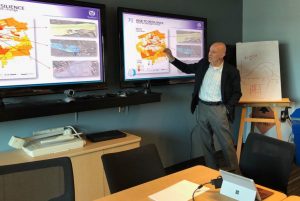
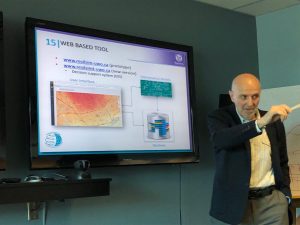
The brief summary of his lecture:
Damages to urban water infrastructure systems have escalated in recent years as a result of various natural hazards. The observed trend is expected to increase in the future as the impacts of population growth, rapid urbanization and climate change persist. There are practical links between disaster risk management, climate change adaptation and sustainable development leading to the reduction of disaster risk and re-enforcing resilience as a new development paradigm. There has been a noticeable change in the approaches to management of disasters, moving from disaster vulnerability to disaster resilience; the latter viewed as a more proactive and positive expression of community engagement with disaster risk management. Multiple case studies reveal links between attributes of resilience and the capacity of complex water infrastructure systems to absorb disturbance while still being able to maintain a certain level of functioning. Use of resilience as an appropriate matrix for investigation arises from the integral consideration of overlap between: (a) physical environment (built and natural); (b) social dynamics; (c) metabolic flows; and (d) governance networks. This presentation provides an original systems framework for quantification of resilience. The framework is based on the definition of resilience as the ability of complex systems to absorb disturbance while still being able to continue functioning. The disturbance spatial and temporal characteristics depend on the direct interaction between impacts of disturbance (physical, social, health, economic, and other) and adaptive capacity of the system to absorb disturbance. This presentation proposes the use of quantitative resilience concept (a management measure that is dynamic in time and space) to assess the response of an urban infrastructure system to the consequences of natural hazards.
The implementation of the concept has been done in the form of the web-based decision support system (www.resilsimt-uwo.ca) that operates in near real-time. It is designed to assist decision-makers in selecting the best options for integrating adaptive capacity into their communities to protect against the negative impacts of a hazard. The tool is developed for application in Toronto, Ontario, Canada. It is observed how the incorporation of different combinations of adaptation options maintains or strengthens Toronto’s basic infrastructure systems and their functions in the event of different natural disasters.
The Second Speaker: Dr Lin Ju
Dr Lin Ju, PMP®, Senior Development Manager, Watson Studio, IBM Data & AI, IBM Canada. The title of her lecture was "Developing Artificial Intelligence enabled application through Watson Studio for natural hazards".

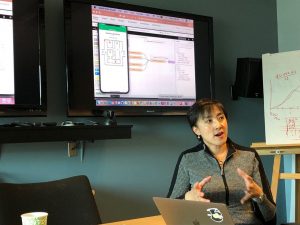
This is the brief summary of her presentation:
Natural disasters are major adverse events resulting from natural hazards, which can cause loss of life, injuries, property damage and typically leave some economic and environmental impact. We seek to apply the latest technology to help predict, plan, prepare and respond ahead of these external sources of destruction. But application developers are struggling to quickly embrace Artificial Intelligence (AI) and deep learning to build AI functions into applications. In order to accelerate the development and democratization of AI applications, we will present and demonstrate how to quickly develop a mobile AI application that can be used in schools for earthquake preparation and response to disaster through IBM IoT Platform and Watson Studio.
Links for further information:
https://developer.ibm.com/blogs/women-in-watson-lin-ju/
www.frida-ai.org
November 2018 Seminar
ADERSIM November 2018 seminar focused on "Modelling Infectious Disease Outbreaks" and Dr. Jane Heffernan and her team presented their lectures on Wednesday, Nov. 28 at 12 pm. The first speaker, Mohammed Althubyani, spoke about "a metapopulation model incorporating geographic mobility process to study H1N1 in Hajj". The second speaker, Elena Aruffo, presented her speech on "immigration effects in immunity in Canada" and the title of Dr. Heffernan's lecture was "effects of waning immunity on measles dynamics in a population".
Dr. Jane Heffernan at ADERSIM November 2018 seminar
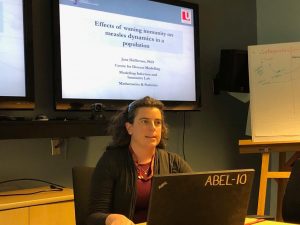
The summary of the seminar lectures:
Whether at home, or travelling abroad, infectious diseases pose risks to
all individuals continuously. Characteristics that affect the risk of
infection include an individual's immune system status, transmissibility
of the pathogen, the number of contacts that the individual has with
others each day, and also the immune status of the contacts that they
have. Mathematical models can be used to quantify the effect of each of
these characteristics on an infectious disease outbreak. In this
presentation we will describe mathematical modelling studies that we
have conducted on infection spread at (1) a mass gathering of
individuals from many different countries (the Hajj), and (2) in a
diverse immigrant and Canadian-born population. The effects of
demographics (natural birth and death), travel, and immigration rates
will be discussed.
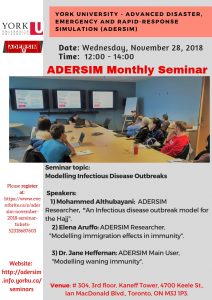
October 2018 Seminar
The seminar was held on Wednesday, October 31, 2018, from 12:00 till 14:00 and almost 30 people from different backgrounds attended the event. Following is the summary of the lectures.
The first speaker: Dr. Kazi Rahman

Forced Migration Scenario Simulation Using An Agent-based (ABM) Modelling Tool
Given the unprecedented levels of forced displacement and the recurrent problems in addressing large-scale movements, a community of social and computer scientists in collaboration with humanitarian actors is working to use ‘big data’ to develop an evidence-based simulation tool that can identify patterns of displacement and support the planning of humanitarian responses (e.g. the location of shelter, food, supplies). Here, we present an agent based modelling tool which could be used to address complex reasons for movements of people, particularly in context of mixed movements (e.g. economic factors, conflict, human rights violations/persecution/torture, environmental change, safety level etc.) in order to be better prepared for assisting and protecting displaced populations. This research is a part of the main project “Building Bridges across Social and Computational Sciences: Using Big Data to Inform Humanitarian Policy and Interventions”. If interested, more details can be found at http://fmbd.info.yorku.ca/
The second speaker: Dr. Nirupama Agrawal
Disaster Adaptiveness, Resilience, and Capacity Building by Accounting for People's Perceptions: A Canadian Case study
The objective of the study was establishing a comprehensive approach to estimate disaster resilience by integrating qualitative and quantitative approach for the purpose of developing a unified strategy for resilience in Canada. The case study was Brampton city in GTA. Subjective data gathered through surveys and objective data obtained from Canada census and GIS datasets. Main parameters were Susceptibility, Exposure, and Lack of Coping Capacity. Finally, this study developed a formula to determine resiliency in a city.
The third speaker: Dr. Jungwon Kang
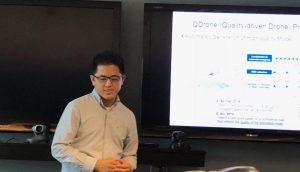
Introduction to QDrone project: Toward quality-driven autonomous mapping using a drone for infrastructure inspection
The use of drones has become increasingly popular in infrastructure inspection since current professional-grade drones have favourable aspects with respect to cost, efficiency, and accuracy compared to traditional human-centric inspection process. However, despite recent remarkable advances, drone technology is not yet fully optimized for the inspection tasks. The QDrone project began to address the issues in autonomous mapping for infrastructure inspection. For autonomous mapping, the drone should be able to start the operation and take off, fly to a designated area while avoiding obstacles as perceived, search for and locate the object of interest in the designated area, acquire adequate data from the area, and safely return to home. Furthermore, producing a complete 3D model for the designated area is vital for the inspection tasks. Hence, in this project, we are building a unified pipeline for localization, perception, mapping, and navigation for the drone. Moreover, in order to improve the quality of the produced 3D model, we will develop an autonomous mapping technique that drives a drone to build the model based on the quality of the model being produced. In this talk, we will introduce the QDrone project and present current progress of the project, including UWB-aided localization and deep neural network-based perception.
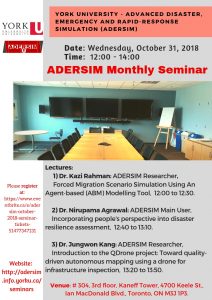
May 2018 Seminar
Wednesday, May 30, 2018


